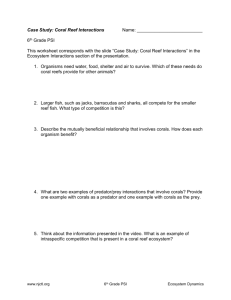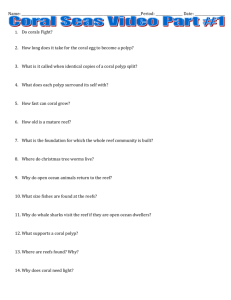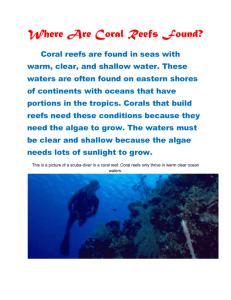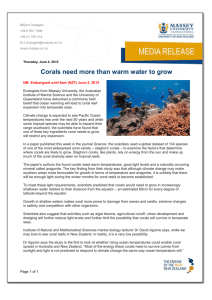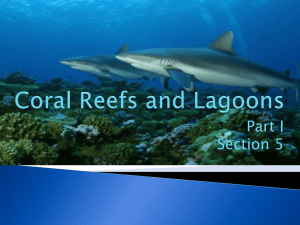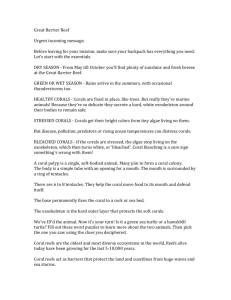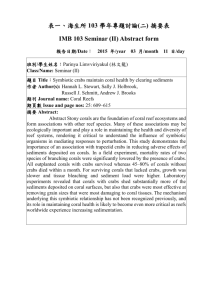Coral Reef Requirements
advertisement
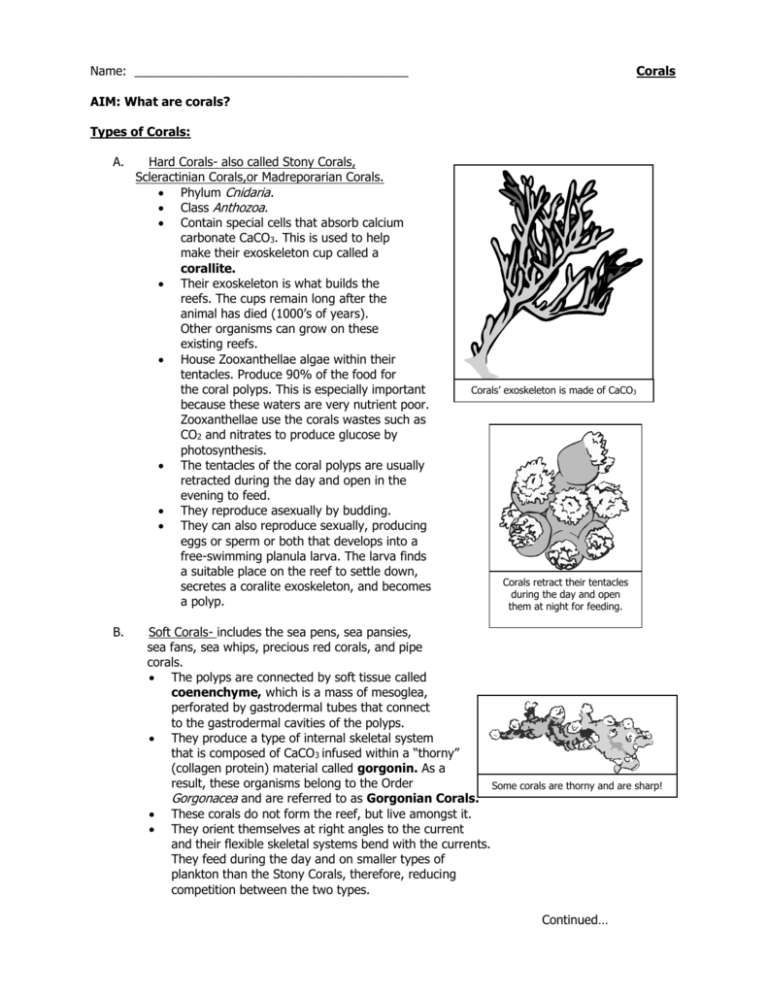
Name: ________________________________________ Corals AIM: What are corals? Types of Corals: A. B. Hard Corals- also called Stony Corals, Scleractinian Corals,or Madreporarian Corals. Phylum Cnidaria. Class Anthozoa. Contain special cells that absorb calcium carbonate CaCO3. This is used to help make their exoskeleton cup called a corallite. Their exoskeleton is what builds the reefs. The cups remain long after the animal has died (1000’s of years). Other organisms can grow on these existing reefs. House Zooxanthellae algae within their tentacles. Produce 90% of the food for the coral polyps. This is especially important because these waters are very nutrient poor. Zooxanthellae use the corals wastes such as CO2 and nitrates to produce glucose by photosynthesis. The tentacles of the coral polyps are usually retracted during the day and open in the evening to feed. They reproduce asexually by budding. They can also reproduce sexually, producing eggs or sperm or both that develops into a free-swimming planula larva. The larva finds a suitable place on the reef to settle down, secretes a coralite exoskeleton, and becomes a polyp. Corals’ exoskeleton is made of CaCO3 Corals retract their tentacles during the day and open them at night for feeding. Soft Corals- includes the sea pens, sea pansies, sea fans, sea whips, precious red corals, and pipe corals. The polyps are connected by soft tissue called coenenchyme, which is a mass of mesoglea, perforated by gastrodermal tubes that connect to the gastrodermal cavities of the polyps. They produce a type of internal skeletal system that is composed of CaCO3 infused within a “thorny” (collagen protein) material called gorgonin. As a result, these organisms belong to the Order Some corals are thorny and are sharp! Gorgonacea and are referred to as Gorgonian Corals. These corals do not form the reef, but live amongst it. They orient themselves at right angles to the current and their flexible skeletal systems bend with the currents. They feed during the day and on smaller types of plankton than the Stony Corals, therefore, reducing competition between the two types. Continued… They also have many symbiotic organisms living on them such as colonial tunicates, barnacles, bivalves, snails and gobies. Their color comes from pigments within the skeletal framework. They also contain Zooxanthellae algae. Cities in the Sea: Reefs provide food, protection, and social life. “Oasis” within a desert-like environment. Fierce competition for resources. Less organisms than in cooler Northern waters. Few plankton, minerals, decaying plants and nutrients. Fish often have bright markings as warning coloration. Specialization in habitats, diet, and niche allow each organism to occupy its own place in the community. 3 distinct periods of activity in the reefs. 1. 2. 3. Corals are important for symbiotic relationships in aquatic ecosystems. diurnal (active by day)- about ½ to 1/3 of fish species. They are usually brightly colored and have well developed eyes to detect color. nocturnal (active at night)- about ¼ to 1/3 of fish species. Rely on sense of smell, taste and touch. Some have huge eyes. Most invertebrates are nocturnal too. crepuscular (dawn/dusk)-about 10% of fish. Mainly large predators such as reef sharks, barracudas, and groupers. Color Adaptations: Warning Coloration- poisonous or taste bad. Some organisms can change color when excited, angry or threatened. Disruptive Coloration- Stripes or splotches to break up the body’s silhouette, and blend in with the corals. Cleaner fish are usually blue and black striped fish, to advertise their role as “safe” cleaner fish. Sometimes non-cleaner fish have blue and black stripes and “mimic” the cleaners. When other fish approach, instead of being cleaned, they get a chunk bitten out of them!! This is an example of Mimicry. Some corals are able to change colors. Feeding Adaptations: Specialized diets require specialized bodies. ex. long-nosed butterfly fish reaches into crevices. ex. Sea horse’s tail anchors it while it sucks up shrimp and plankton. ex. Parrotfish has a fused “beak” for scraping of coral and grinding it up. It will pass out sand. Breeding Adaptations: Usually occurs at night, fewer predators, gives the eggs, sperm and newly formed larvae a better chance at survival. Usually mass spawning occurs in response to environmental cues. Continued… Coral Reef Requirements: Clear, fairly shallow water; maximum depth 250 ft (76 m); corals that live below 150 ft (46 m) are not reef building corals. Waves and currents deliver food and O2 to coral polyps. Warm temperatures: 75o- 80o F (24o-30o C). Salty seawater. Location of Existing Reefs: Great Barrier Reef (NE coast of Australia). There are specific Indonesia environmental Small islands in the Caribbean Sea. requirements for corals to grow (see left). Red Sea Indian Ocean Restricted to a belt 3,000 miles wide that encircles the equator. Cover 80 million square miles (25x the area of the US). Longest reef is the Great Barrier Reef which is 1,250 miles (2000 km). Growth of coral is ½ inch to 6 inches per year. Formation of Reefs: Form along the shores of islands and continents. 3 different types. A. Fringing reef- develop as coral grows in the shallow waters along the shores of an island. Continued… Barrier Reef- Grows off the coast of an island or continent at some distance away from the shore. A lagoon separates a barrier reef from the shore. Atoll- Circular reef with a lagoon in the center. Grows on submerged islands and sinks due to volcanic action. Continued… Types of Coral Reefs Human Impact on the Reefs: Coral Bleaching- Occurs when Zooxanthellae are ejected from the coral, which results in death of coral polyps. Results from: 1. Changes in temperature. 2. Freshwater runoff. 3. Silt runoff, which increases turbidity (cloudiness). 4. Too little sunlight for algae. 5. Pollution. 6. Global warming. Over-harvesting for commercial purposes- Fishermen dynamite reefs to capture fish to be sold to aquariums. Fish are stunned and are easily scooped out with nets. Others use poison (Sodium Cyanide) to draw fish out of hiding. Many fish die immediately and about 80% will die from the long-term effects of the poison within a few weeks or months. Sporting Activities- Damage by divers, boaters, anchors- breaks up pieces of the reef and kills organisms. Construction- New homes and vacation resorts-produces excess sand that clouds the water. Also more people= more sewage runoff, which promotes algal blooms that also cloud the water and reduce sunlight reaching Zooxanthellae algae in polyps. What can be done? Environmental organizations can campaign for the protection of reefs and creation of sanctuaries. Cooperation of government programs to provide funding and protection to designated areas of importance. Pet storeowners and customers demand that fish be harvested humanely or bred in captivity, if possible. Reduce pollution of all types. Reduce building near coastlines.
